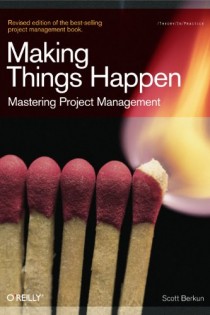How to make smart project decisions: the checklist
 Yesterday I was working on a complex project and found myself stuck. I was out of time and had to make a tough decision. I’d been thinking it over and over in my mind for days but was still unsure. Then I remembered: I’ve done all this before. In my book Making Things Happen I wrote an entire chapter about how to make good decisions as a project manager. And to write that chapter I’d read dozens of books on decision making and overcoming project challenges. Even writers forget the things they’ve written.
Yesterday I was working on a complex project and found myself stuck. I was out of time and had to make a tough decision. I’d been thinking it over and over in my mind for days but was still unsure. Then I remembered: I’ve done all this before. In my book Making Things Happen I wrote an entire chapter about how to make good decisions as a project manager. And to write that chapter I’d read dozens of books on decision making and overcoming project challenges. Even writers forget the things they’ve written.
In Chapter 8 of Making Things Happen, there’s this list, perfect for a quick skim when stuck on a big choice:
- What problem is at the core of the decision? Decisions often arise in response to new information, narrowing your thinking on what the decision actually is. Someone might realize “We’ don’t have time to fix all 50 issues before launch”, which sets many managers off in frantic scramble to hand pick which to fix. But a better, and less narrow problem, is “we don’t have a criteria for triaging issues”. Deciding on that criteria will make dozens of other decisions easier and delegatable. Ask questions like: What caused this problem? Is it isolated or will we deal with this again? Did we already make this decision? If so, do we truly have grounds for reconsidering it?
- How long will this decision impact the project? The longer the impact, the more time you should spend considering the decision.
- If you’re wrong, what’s the impact? The more possible damage in being wrong, the more time you should spend on the decision. The phrase “death by a 1000 paper cuts” refers to a series of small decisions that seem inconsequential individually, but if the same failure is made in dozens of them a compounded and serious problem arises.
- What other decisions will be harder? easier? Some decisions avoid big issues and make them harder to deal with later. Other decisions take on my responsibility in the present, and make things easier in the future. Walk ahead a few weeks in your mind for each option you’re considering and compare.
- What is the window of opportunity? If you wait too long to make the decision, it might be made for you. Big decisions don’t necessarily come with commensurate amounts of time to consider them. And sometimes the speed of making a decision is more important than the quality of the decision itself.
- Have we made this kind of decision before? This is the arrogance test. If stranded on an island you had to perform heart surgery to save your friends life, how confident would you be? There’s no shame in admitting you’ve never done the thing you need to do right now. If a decision maker admits ignorance or inexperience there’s a chance someone else can fill the gap or offer advice based on what they’ve done before. Don’t pretend you know everything: you make worse decisions for the project when you do. Do some reading or networking to find someone who has been in the situation you’re in now.
- Who has the expert opinion? (Is this really my decision?). Just because someone asks you to decide doesn’t mean you’re the best person to make the call. Often the best decision possible is to delegate it to someone better able to make the decision. Or to at least pause the proceedings until you can get the advice of the best expert available.
- Whose approval do we need? In large organizations it’s just as hard or harder to get the approvals you need to make something happen as it is to sort out the decision itself. The sooner you know the map of the hills you need to run up to get everything approved, the greater the odds you’ll be able to make a good decision in time for it to matter.
- Make a pro/con list and use it to get feedback on your thinking. It’s a grade school technique but forces you to clarify both sides, and gives you an easy too for getting feedback on your thinking from other people. Often just explaining your thinking to another person forces you to think more clearly and you’ll find better alternatives or more confidence in an already proposed choice.
And I’d add:
- The bigger the decision, plan more time for exploring alternatives. Some people think spending time seeking alternatives when they already have a good choice is waste. Spending time exploring other options always raises good questions about the choice you have in hand and improves your thinking. Even if you stay on the same path, you’ll likely improve the details of the path based on what you learned while looking at alternatives.
If you liked this, get the book Making Things Happen, my bestseller on leading project teams. You can read a free chapter on the amazon page.

This could also be applied to making life decisions, which is what I’m going to use it for.